 I have been dreaming of big game hunting in Africa for decades. I imagined myself, double-rifle toting my way into a clearing occupied by a pride of man-eating lions, or calmly drawing a bead, with my Rigby, as an elephant charges and my guides scamper for cover.
I have been dreaming of big game hunting in Africa for decades. I imagined myself, double-rifle toting my way into a clearing occupied by a pride of man-eating lions, or calmly drawing a bead, with my Rigby, as an elephant charges and my guides scamper for cover.
I’ve had memorable hunting adventures such as dispatching a 10 ½ foot Florida alligator with a knife, knocking down dozens of doves in Argentina with a 20-gauge Benelli, eliminating sounders of wild Texas hogs with a night-vision-equipped AR-15, dropping passels of colorful pheasants in Colorado, and coveys of lightning-quick quail down in Georgia. Those were all excellent hunting adventures; however, they were not a real safari!
The Purchase
I attended a Friends of the NRA dinner in April, 2015. The camaraderie with gun owners, the games and auctions for guns and gear, it was all enjoyed by hundreds. However, when the auctioneer arrived at the South African safari $6,000 hunting package, a hush fell over the crowd. Always having had a safari adventure in mind but never really thinking one financially possible, a chance at six days and six nights in South Africa’s Limpopo province was irresistible. I low bid $1,000. Going once, twice, three times… I won! “OMG”, bucket list check-off time! I decided that my son would tag along for me and share in the adventure. Now, I just had to explain spending so much money to the wife!
The Outfitter
Diekie Mueller Safaris is run out of the Limpopo Province of South Africa, a four-hour drive north from the Johannesburg International Airport. A white Afrikaner of Dutch descent, Diekie is a professional hunting guide (PH) through and through. His 22 years as a PH means that he knows the look and behavior of every sub-Saharan game animal intimately. He additionally knows how to read tracks, how to stalk, how to read wind, how to identify the trophy buck in a mob of animals and, importantly, how to quickly and properly set the shooting sticks to maximize his client’s chance for success. Diekie’s last 15 years as owner of DM Safaris means he knows how to run a business, manage employees, host American clientele and, how to properly manage the genetic diversity of the game animals on his lands. And, Diekie is known for growing them big!
Preparation
Marksmanship: Over the last few years I have attended two Lucid Optics Long Range Marksmanship Clinics, Neal Ashe’s Precision Rifle Workshop, The RWVA’s Appleseed Shooting Clinic and Spartan Tactical Ranch’s Combat Carbine Course. I have additionally spent countless dollars at the range sending 5.56mm, 7.62x39mm, 7.62x51mm, 7.62x54R, .338Win. Mag., .338 Lapua and .50 BMG downrange from 25 yards to 1,760 yards. My fundamentals of target identification, sight alignment, breathing, body position, trigger squeeze and follow-through are sound. If my rifle is sighted in and I know the estimated distance and the environmental conditions, I can usually make the shot.
My Son’s Prep: My son had never been on a hunting trip. As a certified NRA Firearms Instructor, I have taught him to safely and accurately shoot rifle, pistol and shotgun. With 10 days between his coming home from college and our departure to Africa, he took the New Hampshire on-line hunter safety course. We additionally spent three afternoons at the range working bolt-action rifles against deer targets as well as sending some .223 down range with an AR-15 because it’s just so much fun. He proved capable of putting all his rounds in a deer target’s breadbasket at 100 yards.
The Targets: This being our first African safari, we had to decided what game to pursue. We decided on plains game as opposed to the Africa’s Dangerous Big 5: Cape buffalo, lion, leopard, rhinoceros and elephant. This was an easy decision as this would be my son’s first big game hunt and my first African safari; and “Buck Fever” could prove lethal in the Bushveld (the region in which the Limpopo Province is located). Moreover, the costs of a Big 5 hunt would mean no more tuition checks, so plains game it would be.
-
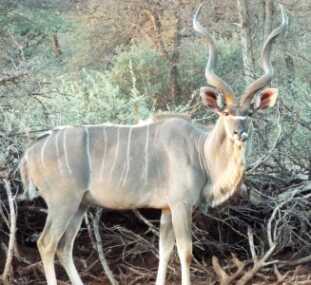
The Kudu is an immensely spiral-horned, thinly-striped, grey ghost of a beast with the reputation of being able to instantly vanish in the thick.
The Magnificent Kudu: A grunting and clucking, immensely spiral-horned, thinly-striped, grey ghost of a beast with the reputation of being able to instantly vanish was definitely on my dream list. Essentially elk-sized, I definitely planned to pursue a +600 pound mature Kudu if we managed to catch a glimpse of one. I knew we would have to be alert, responsive and precise with our rifles if we were to harvest a trophy Kudu.
- The Beautiful Nyala: Aka the Inyala, it is a South African dark-brown or grayish, spiral-horned antelope with extremely distinctive white stripes and dots on its body and face. This animal was a bit of a mystery to me until my research concluded that the Nyala is the most gorgeous of the African plains game. A mid-sized plains animal, its body length ranges from 53- to 77-inches long, and it weighs from 121–309 pounds. while nice American White tails come in at around 100 pounds and up. We decided to pursue a gorgeous male Nyala.
- The Immense Eland: The blue-grey coated, Eland is the largest spiral-horned antelopes on the planet. The giant eland has very thick and tough 17- to 20-inch horns, a really dense patch of thick brushy fur on its forehead and a large flappy dewlap on its throat. Typical Eland bulls weigh between 1,000 and 2,000 pounds! These humongous beasts of the Bushveld are about twice the weight of New England Moose while standing about the same 6-feet in height. Unbelievably, these massive beasts can be extremely elusive in the Bushveld. They are statuesque, noble animals and, as such, the massive Eland made our dream list.
-

The game that was observed during the safari, such as this Roan antelope, was varied and impressive.
The Ubiquitous Impala: The impala is a medium-sized, very fast antelope native to eastern and southern Africa. Very numerous like our whitetails, the impala is about 3-feet high at the shoulder and weighs in between 88 and 168 pounds. Size and coloration is very similar to whitetail although the antlers are smaller and more twisty, ranging from 18- to 36-inches long. Impalas can jump 10 feet up and 30 feet away while twisting its hind quarters sideways and bouncing like a bull trying to throw a cowboy. They grunt really loudly during the rut and will sprint and jump recklessly while fighting for females.
- The Blue Wildebeest: The name Wildebeest means “wild cattle” in Dutch. These blue-gray, brown-black striped animals run about 5-feet tall and 500 pounds. They have short, wickedly curved horns featuring a really thick boss, and a bushy/stringy mane and beard. Migrating herds of them are usually seen being attacked by crocodiles and lions on Animal Planet TV.
- The African Warthog: A distant cousin to our American feral hogs. As I love hunting wild Texas hogs, the African cousin was a natural for our list. Males can grow up to 330 pounds and one truly wants to stay out of the way of the two pairs of curved tusks which protrude from its mouth. The uppers are wickedly hooked and the lowers are known to be razor sharp.
Sighting in
We decided to use rifles provided by Diekie Mueller instead of bringing ours across the Atlantic. We correctly anticipated that he would have high-quality, reliable and accurate rifles. After arriving at the hunting lodge, we descended from the truck, parted a herd of Jack Russel Terriers and stowed our gear. We quickly got geared up and headed to the range in the afternoon heat.
From the bench, we punched paper from 100 yards. Nothing exotic about the reliable Sako .270 Win. or the Cogswell & Harrison .375 H&H bolt-action rifles he provided. The .270 was fed with 150 grain Swift A-frame bullet ammunition and the .375 with 300-grain Hornady Dangerous game expandable bullet ammunition.
My son and I found the triggers crisp, the safeties functional, the recoil negligible and the Leupold 3-9X scopes accurate. Neither my son nor I had ever shot off shooting sticks and it took us a minute to get used to them. He and I both, adequately, grouped a couple of shots with each of the rifles. Our PH was satisfied and we were confident that we could reliably and effectively operate the rifles from shooting sticks in the field.
The Impala Stalk
Trotting mindfully, in a highly elevated state of awareness, mere steps behind the rugged and stocky Afrikaner PH, I concentrated on avoiding stepping on twigs and being slapped by fragrant, thorn-adorned whippersnappers, so as not to give our position away. Dodging long thorns and the holes left by a variety of anteaters and warthogs while conscientiously avoiding muzzle sweeping the back of my PH’s skull with the lethal Cogswell & Harrison .375 H&H chambered bolt-action big game rifle, we pursued our prey. Breathing heavily but as silently as possible, pooled perspiration leaking from under my hat, my heart beat a tattoo within my chest. I intently speed-walked, dancing, ducking and dodging the branches. I was on the hunt.

The author (right) was able to take this beautiful Impala with the expert guidance of professional hunting guide Diekie Mueller (left).
Physiological stress, scratched skin and a newly air-conditioned sleeve were the result of stalking an Impala herd through heavy Acacia thorns, spider webs and scrub brush of South Africa’s Limpopo Bushveld. My PH stops short. I arrived, nearly silently at the correct location. My PH conjured the shooting sticks into the correct position for my 6-foot, 1-inch frame and whispered, in a heavy Afrikaner accent, “That one; the one with the huge rack.” In acknowledgement, I quickly secured the rifle stock in the V and positioned my body to harvest my prey. The Leupold’s crosshairs precisely aligned just behind the animal’s shoulder; cheek securely welded to the rifle butt I tighten my grip, control my breathing and squeeze the trigger. Boom said the .375 H&H caliber rifle. Adrenalin flooded my veins. I felt no recoil against my shoulder, but I clearly see and hear the bullet smack my prey 80 paces from my muzzle. Muscle memory makes me work the bolt, chambering another .375 H&H solid just in case. It was not necessary as I watched my Impala hop back, stand, twist, stagger, stumble and collapse into deep brush after the impact. The PH unleashes a brief victory cry, smacks me on the back and offers his hearty congratulations.
The Eland Hunt
The morning chill was a distant memory. As we dodged the thorns, branches and anteater holes, the sweat started to cascade off my skull and down my back. The sun blazed away in a brilliant blue African sky. We had been bush-whacking for a while, seeing tracks and spore from Wildebeast, Hartebeast and Kudu before surprising a Zeal of Zebra. We watched them gallop away, spooking all other game animals within earshot, then we took a water break.
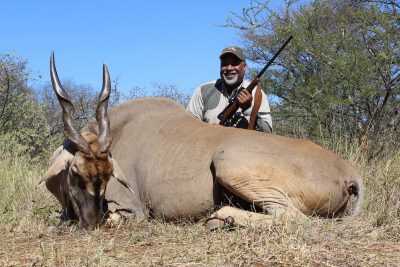
The author was able to take this impressive Eland, a massive blue-grey coated, spiral-horned antelope.
The PH climbed up into a tree. He came down saying he saw some fresh tree damage that appeared as if Elands had been dining. Giant Elands feed like a hurricane. Their burly horns shatter Acacia trees in order to get to the tender top shoots and leaves they find delicious. The aftermath looks like a hurricane or tornado has come through the area, leaving a trail of destruction.
Saddling up, we recommenced our stalk. Shiny dung piles indicated we were pursuing from the proper direction. They were moving a bit; but we were approaching into the wind, probably OK. Cautious step after step. Peering left, then right, then in front. Craning the neck, glassing from time to time.
Our PH froze. We did the same two milliseconds later. He set up the sticks while pointing east. About 100 yards away was a small herd of Eland browsing and drifting toward heavier cover. He whispered “that one,” indicating a heavy, mature bull on the edge of the group.
Training took over my mind. The .375 H&H quickly nestled in the sticks, my cheek welded to the stock, I acquired the target in the Leupold 3-9X. Putting the crosshairs on the massive Eland’s shoulder I squeezed the trigger. BOOM! Smack, I heard the bullet strike (I think). I worked the bolt, feeding a fresh cartridge into the chamber. The Eland jumped in the air, spun sideways and took off. The PH sprinted in pursuit. We followed; me being cognizant of my muzzle direction while running, jumping logs and dodging thorns.
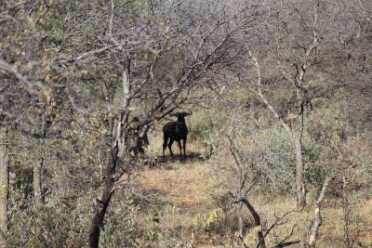
Stalking skills along with a cool hand and steady marksmanship are key to success on a safari. Shown is a wary Wildebeest.
There was a trail of bright red, highly oxygenated, blood; and bone shards. More blood and more bone shards led us right to the spot 20 yards away where the Eland crashed into the brush. Approaching cautiously because they have massive horns, I fired the coup de grace and his lights went out. Another round was chambered because we were still in Africa.
The PH smacked me on the shoulder in congratulations just as the brush exploded behind us. We all pivoted and saw two battling Impala bucks duking it out for the favors of a female. The intensity of their mortal combat was such that they didn’t even react to our presence until they were about 10 yards away. I was raising my rifle to avoid getting run over by one or more of them when they both stopped on a dime; juked, and sprinted from whence they had come. Still experiencing elevated adrenalin levels from the hunt and pursuit of the Eland, we all laughed nervously at the idiotic behavior of the lust-blind Impalas.
A Father’s Joy
It was a pleasure to watch my 21-year-old son confidently and safely wield the Sako .270 Win. with lethal effect in the South African Bushveld. Seeing his gun-handling, expertly employed, in a single off-hand shot that instantaneously dropped a massive Kudu was the highlight of my safari. I marveled as he worked the bolt with fluidity and authority to be instantly prepared in case a follow-up show might be required.
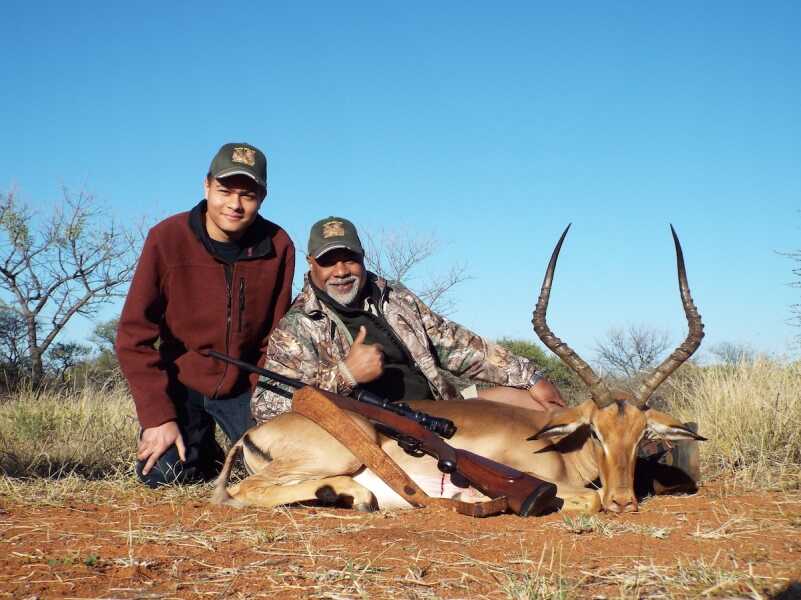
The safari was a bonding experience for the author and his son, and a memory they no doubt will both cherish.
[one_half]
[/one_half]
[one_half_last]

The author’s son found the safari experience to be everything he had imagined it to be. He is shown here with the Nyala he took.
[/one_half_last]
Quick of mind and young of eye, he proved capable of spotting and identifying game in a flash. Excitedly and persistently stalking game through the briars and brambles of the South African Bushveld despite the heat, his embrace of hunting was obvious. He listened attentively to the instructions and advice of the PH. His vision and reaction eventually led to his nailing of a most-magnificent Nyala with one offhand shot, just as dusk was melting to darkness. The constellation known as the Southern Cross photobombed us in heavenly celebration as my son joined the fraternity of African big game hunters.
Other Fauna Encountered
Cape Buffalo: The dangerous one ton-plus animals with heavily bossed horns are known to be responsible for killing more hunters than any other animal in Africa. They are especially dangerous after having been wounded and often charge the hunting party, leaving it severely bloodied and viciously mangled. It is said that Cape buffalo can kill lions, tip over cars and carry a lot of poorly placed lead, as their strength is 4 times that of an ox.
My hunting party had the great fortune to spot several of the dark behemoths, each within 50-75 yards, as we stalked through the Bushveld. I was heartened to be carrying a .375 H&H, but I would have felt even better to have had a .500 Nitro Express in my hands. The heart rate instantly accelerated as the strength and danger radiating from the magnificent beasts filled the air. We froze. Fortunately for us, after staring us down, they turned tail and silently disappeared into the bush. I remember thinking to myself that it is unbelievable that such a huge beast can become invisible in such a small amount of cover.
This sighting, of a dangerous “old dugga boy” and his companion females, made the realization that we were in the true African bush very real. The tattoo being beaten inside my chest proved that my son and I were undertaking the adventure I had been desiring for most of my life.
Giraffe: They were not on my hunting prey list as my house just isn’t large enough to hold a Giraffe mount, nor do I think I would care to dine on Giraffe flesh. We shall see how I feel in the future, especially if I am able to ever buy a mansion with really high ceilings!
In any case, on several occasions we would run across a Tower of Giraffes (the name for a group of them) while driving to the hunting land or while stalking an animal. They are as awkward and goofy looking, towering above the Bushveld, as they look on television, so we had to stop our stalk and just check them out. Seeing the Tower of Giraffes’ rambunctious behavior while feeding in the wild injects a bit of pure joy into the heart and a wide smile to the face.
Zebra: Wild Zebras are magnificent on the hoof. I think I will harvest one in the future. In any case, a herd of Zebra is known as a Zeal and there were quite a few trotting through our corner of Limpopo Province’s bushveld. We often spotted them off in the distance. Alert, skittish and fast, the zebra is a challenging game animal. Their stripes truly do act as excellent camouflage in the bush. I still don’t quite understand why.
White-Bellied Go-Away Bird: These ½- to 2-pound Go Away Birds fly all over the Limpopo Province’s bushveld. Their cry, hated by hunters both four-footed and two-footed, alerts prey animals that something dangerous is lurking in the shadows. They have ruined many a near-successful stalk as their cry sounds like “Go Away Go Away.” They busted us several times and as a result we lost animals completely or just saw their tails and they galloped away.
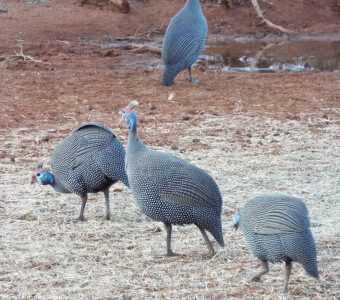
Guineafowl have grey/blue plumage and fairly large bodies and are a popular food source for the local population.
Weaver/Social Weaver: There are more than 50 different genre of colorful Weaver birds in Africa. What I found most interesting about these small birds is their nests. Weavers literally weave their nests from grasses, leaves, hair, etc., and hang them from trees. My PH told me that the male weaves the nest which the female then inspects. If inspection is passed, the female agrees to move right in. If not, she cuts it down with her beak. The male must then return to Home Depot. Our PH informed us that nests of the weavers can be used as a navigation tool if there is no sun, as they are almost exclusively built on the leeward side of trees.
Helmeted Guineafowl: The local Africans love to eat Guineafowl according to our PH. We saw flocks of them every morning, at the extent of our eyesight, as we departed the compound into the hunting grounds. These partridge-looking birds were skipping, strutting and parading all around the waterhole and wood pile near the blind we sat in one afternoon. Guineafowl have grey/blue plumage and fairly large bodies, weighing in at 1.5 to 3 pounds.
South African Animal Husbandry
In Africa today, the primary reason there are healthy herds of animals is because the trophy fees paid by big game hunters permit the game ranchers to pay careful attention to the management of genetic diversity. Older bucks are harvested by hunters so as not to replicate their genes into their grand-daughters and great grand-daughters. Additionally, a good number of reproductive-age females are rounded up and exchanged with game ranchers in other parts of the continent every couple of years. This purposeful relocation activity helps keep the gene pool on any 2,000- to 200,000-acre parcel of land fresh, active and unpredictable for hunters. The genetic exchange mitigates both disease and birth defects in the wild herds.
[one_half]
[/one_half]
[one_half_last]
[/one_half_last]
Ranchers and safari outfitters additionally invest in protecting animal herds from malevolent poachers with fencing, armed patrolling of the ranches, and creating a hospitable environment for dangerous game like Cape buffalo and Lions.
Conclusion
To me, getting up at O’dark-thirty, lacing up the hunting boots, pushing the chill away with scalding black coffee, checking the readiness of gun and ammo and then venturing into God’s glorious pre-dawn, means my adventure is about to commence.
Watching your son’s grin as the PH paints his face with the blood of his first kill in unforgettable. The pastor’s smile as you donate 1,000 pounds of meat to his church warms one’s soul. The fragrance of the Acacia, Sage, red clay and the smiles of the camp staff as you tip them will never leave you. I strongly recommend you book your trip while it is still possible, and somewhat affordable, to go on your own African Safari!
[one_third]
[/one_third]
[two_third_last]
[/two_third_last]











I like to visit foreign lands and view magnificent, beautiful and immense creatures and kill them.
If you’re serious then me too, but if that was a lame attempt at sarcasm….GFY.
As most everyone who hunts knows, there’s MUCH MUCH more to it than just the the killing, but killing does occur, so my comment stands.
I prefer to hunt Trolls, on the internet. Problem is, they pop up, squawk, then run like hell!
They are great cowardly beasts, and usually smell like hell!
Great story Devin! I also won a safari bid for $1,000.00. We are going in February. My son in law and I will be hunting with Numzan Safaris. Thanks for a window view on whats to come. We also plan on using the PH’s rifles to avoid the hassel of traveling that far and thru customs with our own firearms. I am curious what type of camera you carried with you. My last Montana hunt would have been even better if my camera had not taken that time to domino.
It was nice to read about a hunt that most will never go on but reading it made me feel like I was there with you.
Devin,
Being the father of adult children with miles of experiences behind us, I know the pride and good feelings that were generated on this hunt with your son. Thanks for sharing! The story was a great one, and I’m sure there will be others like it down the road. Miss you brother. Live well and Godspeed.
VBR, Arnie
Thank you for this engaging and informative article! I thoroughly enjoyed reading it. A big game safari is now on my bucket list. I did not think it was accessible before. Congratulations to Alexander! Priceless father-son memories, indeed!
How was the biltong?
Wow, great hunt! Thanks for sharing. The best part will be the, “father/son,” memories it will impart as the years go by.